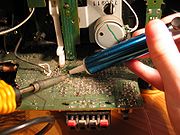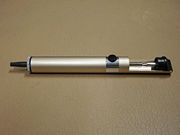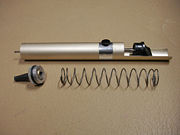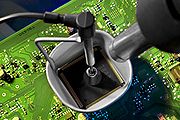
Desoldering
Encyclopedia

Electronics
Electronics is the branch of science, engineering and technology that deals with electrical circuits involving active electrical components such as vacuum tubes, transistors, diodes and integrated circuits, and associated passive interconnection technologies...
, desoldering is the removal of solder
Solder
Solder is a fusible metal alloy used to join together metal workpieces and having a melting point below that of the workpiece.Soft solder is what is most often thought of when solder or soldering are mentioned and it typically has a melting range of . It is commonly used in electronics and...
and components from a circuit
Electrical network
An electrical network is an interconnection of electrical elements such as resistors, inductors, capacitors, transmission lines, voltage sources, current sources and switches. An electrical circuit is a special type of network, one that has a closed loop giving a return path for the current...
for troubleshooting
Troubleshooting
Troubleshooting is a form of problem solving, often applied to repair failed products or processes. It is a logical, systematic search for the source of a problem so that it can be solved, and so the product or process can be made operational again. Troubleshooting is needed to develop and...
, for repair purposes, component replacement, and to salvage components. Electronic components are often mounted on a circuit board
Printed circuit board
A printed circuit board, or PCB, is used to mechanically support and electrically connect electronic components using conductive pathways, tracks or signal traces etched from copper sheets laminated onto a non-conductive substrate. It is also referred to as printed wiring board or etched wiring...
, and it is usually desirable to avoid damaging the circuit board, surrounding components, and the component being removed.
Specialized tools, materials, and techniques have been devised to aid in the desoldering process.
Tools
Desoldering tools and materials include the following:- Solder wick
- Heat gunHeat gunA heat gun is a device used to emit a stream of hot air. They are superficially similar in shape and construction to a hair dryer, though they run at much higher temperatures...
s - Desoldering pump
- Removal alloys
- Removal fluxes
- Vacuum and pressure pumps with specialized heater tips and nozzles
- Rework stations, used to repair printed circuit boards that fail factory test.
Desoldering pump


Printed circuit board
A printed circuit board, or PCB, is used to mechanically support and electrically connect electronic components using conductive pathways, tracks or signal traces etched from copper sheets laminated onto a non-conductive substrate. It is also referred to as printed wiring board or etched wiring...
. There are two types: the plunger style and bulb style.
The plunger style is usually a small, spring
Spring (device)
A spring is an elastic object used to store mechanical energy. Springs are usually made out of spring steel. Small springs can be wound from pre-hardened stock, while larger ones are made from annealed steel and hardened after fabrication...
-loaded device that sucks the solder off the soldered connection. It is applied to a heated solder connection, then the user activates the device (usually via button) to suck the solder away. Other models use a powered vacuum pump
Vacuum pump
A vacuum pump is a device that removes gas molecules from a sealed volume in order to leave behind a partial vacuum. The first vacuum pump was invented in 1650 by Otto von Guericke.- Types :Pumps can be broadly categorized according to three techniques:...
instead of spring to generate the vacuum. These pumps are less likely to damage fragile surface-mount components because they have a constant air flow, instead of the sudden, strong air flow of a spring-loaded type.
The bulb style works much like the plunger style, except a bulb is used to create the vacuum. A is a soldering iron with a desoldering bulb attached to it.
Solder wick
A solder wick, also known as a desoldering wick or desoldering braid, is a roll of fine, braided 18 to 42 AWGAmerican wire gauge
American wire gauge , also known as the Brown & Sharpe wire gauge, is a standardized wire gauge system used since 1857 predominantly in the United States and Canada for the diameters of round, solid, nonferrous, electrically conducting wire...
wire typically made from oxygen free copper that has been treated with a rosin
Rosin
.Rosin, also called colophony or Greek pitch , is a solid form of resin obtained from pines and some other plants, mostly conifers, produced by heating fresh liquid resin to vaporize the volatile liquid terpene components. It is semi-transparent and varies in color from yellow to black...
solder flux.
The processes of removing solder with a wick starts by placing the wick over the solder to be removed and then heating the portion of the wick in contact with the joint with a soldering iron
Soldering iron
A soldering iron is a hand tool most commonly used in soldering. It supplies heat to melt the solder so that it can flow into the joint between two workpieces.A soldering iron is composed of a heated metal tip and an insulated handle...
. As the solder wick is heated and the solder reaches its melting point the solder is sucked into the solder wick via capillary action
Capillary action
Capillary action, or capilarity, is the ability of a liquid to flow against gravity where liquid spontanously rise in a narrow space such as between the hair of a paint-brush, in a thin tube, or in porous material such as paper or in some non-porous material such as liquified carbon fiber, or in a...
. The solder wick is then removed along with the heat and the solder is allowed to solidify within the wick, apart from the workpiece. Finally, the used section of wick is discarded.
Technique
Desoldering requires application of heat to the solder joint and removing the molten solder so that the joint may be separated. Desoldering may be required to replace a defective component, to alter an existing circuit, or to salvage high value components for possible re-use. Excess application of heat may damage electronic components or destroy the bond between a printed circuitPrinted circuit
Printed circuit may refer to:* Printed circuit board* Printed Circuit Corporation, an electronics manufacturer...
trace and the underlying substrate.
A single joint can usually be quickly undone with a soldering iron and the use of either vacuum bulb, plunger, or desoldering braid. Once the solder has been melted, the vacuum device is applied to withdraw solder from the joint by a rapid movement of air. Desoldering braid draws up the molten solder by capillary action
Capillary action
Capillary action, or capilarity, is the ability of a liquid to flow against gravity where liquid spontanously rise in a narrow space such as between the hair of a paint-brush, in a thin tube, or in porous material such as paper or in some non-porous material such as liquified carbon fiber, or in a...
; the braid usually contains the same flux
Flux (metallurgy)
In metallurgy, a flux , is a chemical cleaning agent, flowing agent, or purifying agent. Fluxes may have more than one function at a time...
as solder.
Multiple-lead devices require special care in removal. For through-hole mounted devices, special soldering bits that facilitate even distribution of heat over all the leads at one time can be used. For factory re-work, a temperature controlled rework station may contain such bits, hot-air systems, and a vacuum system to facilitate removal of the part. Large surface-mounted components require special tooling for production desoldering, although various and improvised methods can be successfully applied for field service. In some instances it is better to destroy the part by cutting off its leads and removing the leads individually, instead of risking damage to the printed circuit board.
Hobbyists may even use a torch or hot air gun to rapidly heat all parts on a board and remove them; such methods are extremely difficult to apply without damaging parts or boards and may result in toxic fumes. Of course, all soldering work (with flux) involves some amount of toxic fumes, which is why ventilation is important.
Quad flat packages

Integrated circuit
An integrated circuit or monolithic integrated circuit is an electronic circuit manufactured by the patterned diffusion of trace elements into the surface of a thin substrate of semiconductor material...
(IC); usually a square IC. Removal of these chips can be problematic as it is impossible to heat all of the leads at once with a standard soldering iron. It is possible to remove them with the use of a razor blade
Razor blade
Razor blade may refer to* A razor* The Razor Blade, a 1920s racing car* Razor blade steel, a type of steel originally designed specifically for razor blades...
or a high-rpm craft tool, simply by cutting off the leads. The stubs are then easy to melt off and clean with a soldering iron. Obviously this technique entails the destruction of the IC. Another method is to use a heat gun
Heat gun
A heat gun is a device used to emit a stream of hot air. They are superficially similar in shape and construction to a hair dryer, though they run at much higher temperatures...
or pencil butane torch
Butane torch
A butane torch is a tool which creates an intensely hot flame using butane, a flammable gas.Consumer air butane torches are often claimed to develop flame temperatures up to approximately...
and heat up a corner, and gently pry it off, working the torch down the leads. This method often leads to traces getting lifted off the PCB where a lead did not get heated enough to cause the solder to flow.
A system under the JBC brand uses extractor shields that concentrates heat where it needs to be, protect surrounding components and avoids damage to the board or the QFP
QFP
A QFP or Quad Flat Package is a surface mount integrated circuit package with leads extending from each of the four sides. Socketing such packages is rare and hole mounting is not possible. Versions ranging from 32 to 304 pins with a pitch ranging from 0.4 to 1.0 mm are common...
. The system takes advantage of the properties of solder by melting it with hot air. The extractor has a spring system that gently pulls the IC upward when the liquid stage of solder has been reached. The IC is held by a vacuum nozzle similar to the ones used in pick & place machines
SMT Placement Equipment
SMT component placement systems, commonly called pick-and-place machines or P&Ps, are robotic machines which are used to place surface-mount devices onto a printed circuit board...
. This system prevents damage to the pads on the PCB, the IC, avoids overheating surrounding components and blowing them off and also removes the risk of having operator errors by using tweezers or other tools that damage the PCB or IC.
Another way to remove one of these devices is to use Field's metal
Field's metal
Field's metal, or Field's alloy is a fusible alloy that becomes liquid at approximately . It is a eutectic alloy of bismuth, indium, and tin, with the following percentages by weight: 32.5% Bi, 51% In, 16.5% Sn....
. Take some of the Field's metal wire, and solder it into all the leads of the chip. Fields metal melts at around 140 °F (62 °C) — less than water's boiling point. Once it's applied to all the leads, it stays molten, and the chip can simply be lifted off the board. This has the advantage of not damaging the PCB or the IC.
Further reading
- Hrynkiw, Dave/ Tilden, Mark W.(2002). Junkbots, Bugbots & Bots on Wheels: Building Simple Robots with BEAM Technologyp. 57-58. California:McGraw-Hill/ Osborne. ISBN 0-07-222601-3

